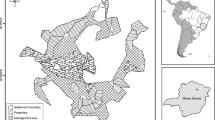Abstract
Live fencing, an age old and traditional agroforestry practice, remains relatively less understood and least documented at least in India. Exploratory surveys conducted in the northern part of the Eastern ghat region of India covering five districts of three states (Andhra Pradesh, Orissa and Chhatisgarh), indicated that traditional farmers have vast knowledge about their live fencing practices and the species used. Two groups of species were observed on the fence. The first group of thirty three species were used primarily for protection and denoted as fence species. Together, they also provide 22 other products and services. The second group of species maintained on the fences for production purposes include five fruit trees, fifteen other trees and two climbers. The fencing practices were classified into two groups (single species and multiple species live fence systems) depending on the species used and into three groups (live fencing around field crops, around backyards or homesteads and around orchards/plantations) depending on the landscapes being protected. Only 20% of fences were dominated by single species; the rest were under multiple species.Ninety percent of house backyards were fenced, whereas only one percent of crop fields and seventy percent orchards were fenced. Some promising fence species of this region are Acacia caesia, A concinna, A. nilotica, Agave sisalana, Annona squamosa, Borassus flabellifer, Carissa carandus, Lawsonia inermis and Murraya koenigii
Similar content being viewed by others
References
E. Ayuk (1997) ArticleTitleAdoption of agroforestry techniques: the case of live hedges in the Central Plateau of Burkina Faso Agricultural Systems. 54 189–206
Budowski G. 1987. Living Fences in Tropical America, a widespread agroforestry practice.. In: Gholz H.L. (ed.), Agroforestry: realities, possibilities and potentials, pp. 169-78. Martinus Nijhoff, Dordrecht, The Netherlands.
G. Budowski R.O. Russo (1993) ArticleTitleLive fence posts in Costa Rica: a compilation of the farmer’s beliefs and technologies Journal of Sustainable Agriculture. 3 65–87
A. Caceres V. Freire L.M. Giron O. Aviles G. Pacheco (1991) ArticleTitleMoringa oleifera (Moringaceae): Ethnobotanical studies in Guatemala Economic Botany 45 522–523
U.M. Chandrashekara S. Sankar P.K. Shajahan M.E. Blowfield E.R. Boa (1997) ArticleTitleFencing patterns in homegardens of Kerala, India: a case study Range Management and Agroforestry System 18 41–53
Cherry S.D., Fernandes E. (1997). Live fences http://ppathw3. cornell.edu/mba_project/livefence.html. Cornell International Institute for Food Agriculture and Development (CIIFAD)
S.S. Dash M.K. Misra (2001) Studies on hill agro-ecosystems of three tribal villages on the Eastern Ghats of Orissa, India, Agriculture Ecosystems and Environment. 86 IssueID3 287–302
L. Fortmann (1985) Trees and Tenure ICRAF Kenya
D. Gautier (1995) ArticleTitleThe pole cutting practice in the Bamileke country (Western Cameroon) Agroforestry System. 31 21–37
Government of Andhra Pradesh, India 1995a. Srikakulum District (1993-94) Chief Planning Officer, Srikakulum. AP, India, 85
Government of Andhra Pradesh, India (1995b). Vizianagaram District (1993-94) Chief Planning Officer, Vizianagaram. AP India, 90
Government of Orissa, India 1999. Districts at a Glance. Brochure, Directorate of Economics and Statistics. Government of Orissa, India.
Hegde N.G., Withington D., MacDicken K.G., Sastry C.B., Adams N.R.(1988). Multipurpose trees for small farmers in India. In: Multipurpose tree species for small-farm use. Proceedings of an international workshop held November 2-5, 1987 in Pattaya, Thailand. 1988, pp 56-64; Co-ublished with the IDRC, Canada, Winrock International Institute for Agricultural Development,Arlington, Virginia, USA
Holst S., Munkert H. 1995. Potential use of live fences in the parklands of the Segou area: a minor field study. Working Paper No. 290, 20 pp. International Rural Development Centre, Swedish University of Agricultural Sciences, Umea, Sweden.
P. Huxley (1997) Glossary for agroforestry ICRAF Kenya
Kaoma C., Kawimbe C., Haazele F., Bruyn T.D., Scogings P.F., (eds) 1998. Strategies for combating the negative impact of seasonal nutritional deficiencies in communal pastures under the smallholder sector.. In: Communal rangelands in Southern Africa: a synthesis of knowledge. Proceedings of a Symposium on Policy Making for the Sustainable Use of Southern African Communal Rangelands, Fort Hare, July 6-9, 1998. pp. 147-150, Fort Hare University Press, Alice, Australia
P.J. Mishra S.K. Dash D. Sahu (2000) ArticleTitleEstablishment pattern of live hedge species in North-Eastern Ghat of Orissa Indian Journal of Soil Conservation. 28 86–87
S.B.B. Oteng’ i C.J. Stigter J.K. Ng’Ang’ a D.N. Mungai (2000) ArticleTitleprotection in a hedged agroforestry system in semiarid Kenya Agroforestry System. 50 137–156
D. Rocheleau F. Weber A. Field-Juma (1988) Agroforestry in dryland Africa ICRAF Nairobi, Kenya 18–19
A. Sajimin B.R. Prawiradiputra M. Panjaitan (1999) ArticleTitleForage integration on farming systems in the district of Bayongbong, Garut Jurnal-Ilmu-Ternak-dan-Veteriner 4 251–256
U. Singh A.M. Wadhwani B.M. Johri (1990) Dictionary of Economic Plants in India Indian Council of Agriculture Research New Delhi, India 288
Subba Rao G.V., Nair N.C., Kumari G.R. 1982. Plant Resources of the Eastern Ghats. Proceeddings of the Seminar on Resources Development and Environment in the Eastern Ghats, 27-33 pp. Andhra Univ. Press, Visakhapatnam, India.
K. Subedi (1993) ArticleTitleAdhatoda vasica (asuro):a superior indigenous green manure species for rice in the hills of Nepal International Rice Research Notes. 18 2–25
J.F. Villanueva-Avalos R. Sanchez-Rodriguez F.O. Carrete-Carreon L. Mena-Hernandez (1996) ArticleTitleEstablishment of different tree species for live fences on the Nayarit coast Tecnica-Pecuariaen-Mexico. 34 64–70
Weber F. and Stoney C. (1989). Understanding agroforestry techniques, Technical Paper # 57. Volunteers In Technical Assistance (VITA), Virginia 22209, USA, 15
Author information
Authors and Affiliations
Corresponding author
Rights and permissions
About this article
Cite this article
Choudhury, P.R., Rai, P., Patnaik, U.S. et al. Live fencing practices in the tribal dominated eastern ghats of India. Agroforest Syst 63, 111–123 (2005). https://doi.org/10.1007/s10457-004-1123-8
Received:
Accepted:
Issue Date:
DOI: https://doi.org/10.1007/s10457-004-1123-8




